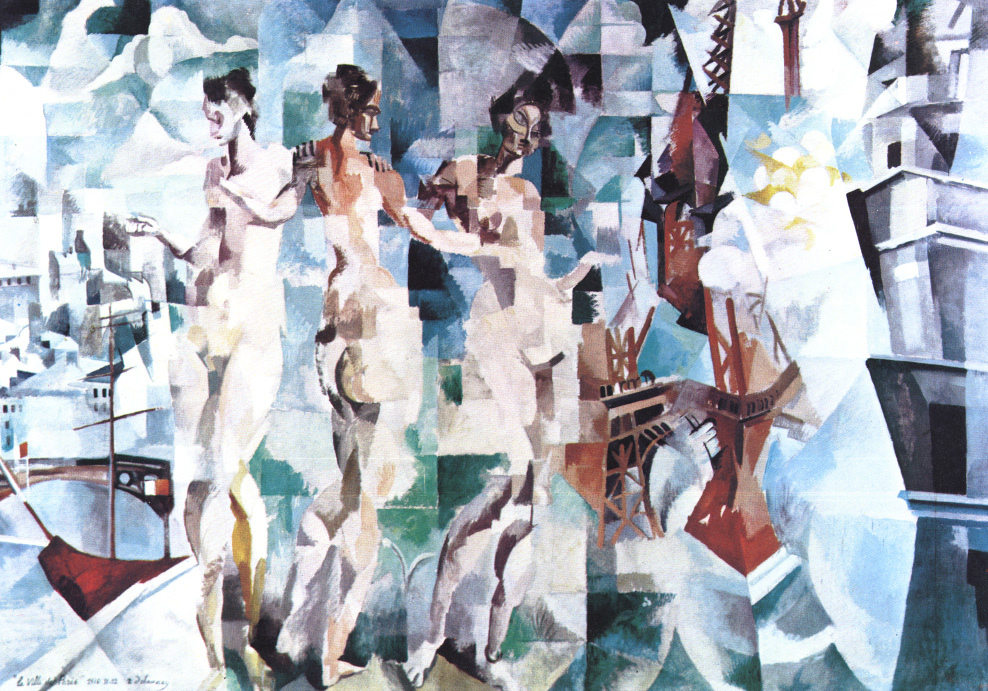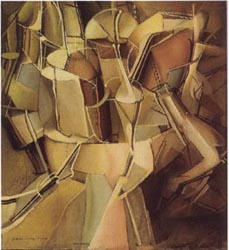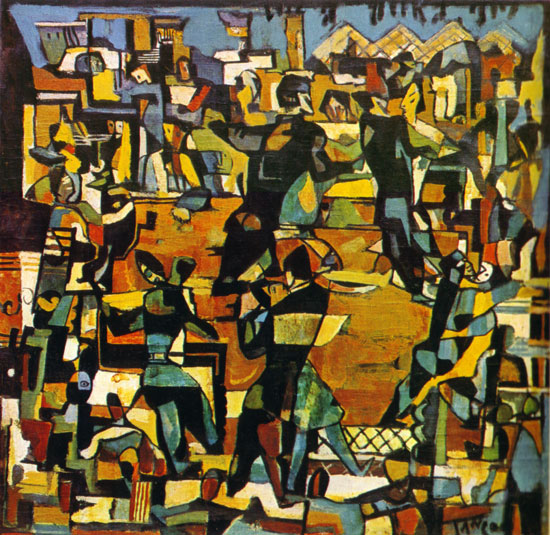
The Section d'Or ("Golden Section"), also known as Groupe de Puteaux or Puteaux Group, was a collective of painters, sculptors and critics associated with Cubism and Orphism. Based in the Parisian suburbs of Puteaux and Courbevoie, the group was active from 1911 to around 1914, coming to prominence in the wake of their controversial showing at the Salon des Indépendants in the spring of 1911. This showing by Jean Metzinger, Albert Gleizes, Robert Delaunay, Henri le Fauconnier and Fernand Léger, created a scandal that brought Cubism to the attention of the general public for the first time. The Salon de la Section d'Or further exposed Cubism to a wider audience. The group seems to have adopted the name Section d'Or to distinguish themselves from the narrower definition of Cubism developed in parallel by Pablo Picasso and Georges Braque in the Montmartre quarter of Paris, and to show that Cubism, rather than being an isolated art-form, represented the continuation of a grand tradition (indeed, the golden ratio had fascinated Western intellectuals of diverse interests for at least 2,400 years).

The Puteaux Group (an offshoot of la Société Normande de Peinture Moderne) organized their first exhibition under the name Salon de la Section d'Or at the Galerie La Boétie in Paris, October 1912. Albert Gleizes and Jean Metzinger, in preparation for the Salon de la Section d'Or, published a major defence of Cubism, resulting in the first theoretical essay on the new movement, entitled Du "Cubisme" (published by Eugène Figuière in 1912, translated to English and Russian in 1913).
Following the 1911 Salon exhibitions the group formed by Le Fauconnier, Metzinger, Gleizes, Léger and R. Delaunay expanded to include several other artists; Alexander Archipenko, Joseph Csaky, Roger de La Fresnaye, Juan Gris, and Jean Marchand, who were virtually unknown to the public before the Salon des Indépendants of 1911, began to frequent Puteaux and Courbevoie. František Kupka had lived in Puteaux for several years in the same complex as Jacques Villon. Francis Picabia was introduced to the circle, perhaps by Guillaume Apollinaire (usually accompanied by Marie Laurencin) with whom he had recently become friendly. Most importantly was the contact established with Metzinger and the Duchamp brothers, who exhibited under the names of Jacques Villon, Marcel Duchamp and Duchamp-Villon. The opening address was given by Apollinaire. The participation of many of these artists in the formation of Les Artistes de Passy in October 1912 was an attempt to transform the Passy district of Paris into yet another art-centre; a further sign of a growing emphasis on communal activity that would culminate in the Section d'Or exhibit.
Albert Gleizes, La Chasse, 1911, oil on canvas, 123.2 x 99 cm. Published in L'Intransigeant, 10 October 1911, "Les Peintre Cubistes" 1913, by G. Apollinaire, and 'Au Salon d'Automne', Revue d'Europe et d'Amerique, Paris, October 1911. Exhibited at the 1911 Salon d'Automne, Valet de Carreau (Jack of Diamonds), Moscow, 1912, and Galerie de la Boétie, Salon de la Section d'Or, Paris, 1912

The 1912 Salon de la Section d'Or was arguably the most important pre-World War I Cubist exhibition. In the previous year the Cubists and a large number of their associates had exhibited at the Galerie de l'Art Contemporain (rue Tronchet, Paris) under the auspices of the Société Normande de Peinture Moderne. This exhibition had received some attention in the press (l'Autorité and Paris Journal), though due to the diversity of the works presented it had been referred to as an exposition des fauves et cubistes. The Salon de la Section d'Or, however, was generally accepted as being entirely Cubist in nature. Over 200 works were displayed, and the fact that many of the artists showed artworks representative of their development from 1909 to 1912 gave the exhibition the allure of a Cubist retrospective.
Though the Salle 41 Cubists had been surprised by the highly impassioned reactions generated by the 1911 Salon des Indépendants showing, they appear to have been eager to attract as much attention as possible with the Salon de la Section d'Or. The inauguration was held from nine until midnight, for which the only precedent was the opening of the 1903 Salon d'Automne. Invitations were widely diffused prior to the show, and many of the guests had to be turned away on opening night (9 October 1912). Lectures by Apollinaire, Hourcade and Raynal were advertised, and a review, La Section d'Or, was published to coincide with the Vernissage; with contributions by Guillaume Apollinaire, Roger Allard, René Blum, Olivier Hourcade, Max Jacob, Maurice Raynal, Pierre Reverdy, André Salmon, André Warnod and others.
The idea of the Section d'Or originated in the course of conversations between Gleizes, Metzinger and Jacques Villon. The group's title was suggested by Villon, after reading a 1910 translation of Leonardo da Vinci's Trattato della Pittura by Joséphin Péladan. Peladan attached great mystical significance to the golden section (French: Section d'Or), and other similar geometric configurations. For Villon, this symbolised his belief in order and the significance of mathematical proportions, because it reflected patterns and relationships occurring in nature. Jean Metzinger and the Duchamp brothers were passionately interested in mathematics. Jean Metzinger, Juan Gris and possibly Marcel Duchamp at this time were associates of Maurice Princet, an amateur mathematician credited for introducing profound and rational scientific arguments into Cubist discussions. The name La Section d'Or represented simultaneously a continuity with past traditions and current trends in related fields, while leaving open future developments in the arts.
Marcel Duchamp, 1912, Nude Descending a Staircase, No. 2, oil on canvas, 147 x 89.2 cm (57.9 in × 35.1 in), exhibited at the Salon de la Section d'Or, 1912, Armory Show, 1913, New York, current location Philadelphia Museum of Art, Philadelphia

The "Section d'Or" group founded by some of the most prominent Cubists was in effect an homage to Georges Seurat. Within the works by Seurat—of cafés, cabarets and concerts, of which the avant-garde were fond—the Cubists' rediscovered an underlying mathematical harmony: one that could easily be transformed into mobile, dynamical configurations. Whereas Cézanne had been influential to the development of Cubism between 1908 and 1911, during its most expressionistic phase, the work of Seurat would attract attention from the Cubists and Futurists between 1911 and 1914, when flatter geometric structures were being produced. What the Cubists found attractive, according to Apollinaire, was the manner in which Seurat asserted an absolute "scientific clarity of conception." The Cubists observed in his mathematical harmonies, geometric structuring of motion and form, the primacy of idea over nature (something the Symbolists had recognized). In their eyes, Seurat had "taken a fundamental step toward Cubism by restoring intellect and order to art, after Impressionism had denied them" (Robert Herbert, 1968).
The fact that the 1912 exhibition had been curated to show the successive stages through which Cubism had transited, and that Du "Cubisme" had been published for the occasion, indicates the artists intention of making their work comprehensible to a wide audience (art critics, art collectors, art dealers and the general public). Undoubtedly, due to the great success of the exhibition, Cubism became recognized as a tendency, genre or style in art with a specific common philosophy or goal: a new avant-garde movement.
The onset of World War I in 1914 largely ended the group's activities.
Guillaume Apollinaire - (1880–1918), French (born in Italy to a Polish mother)
- Alexander Archipenko - (1887–1964), Ukrainian
- Joseph Csaky - (1888–1971), Hungarian, naturalized French
- Robert Delaunay - (1885–1941), French
- Marcel Duchamp - (1887–1968), French
 Minimalism describes movements in various forms of art and design, especially visual art and music, where the work is set out to expose the essence, essentials or identity of a subject through eliminating all non-essential forms, features or concepts. As a specific movement in the arts it is identified with developments in post–World War II Western Art, most strongly with American visual arts in the 1960s and early 1970s. Prominent artists associated with this movement include Donald Judd, John McCracken, Agnes Martin, Dan Flavin, Robert Morris, Anne Truitt, and Frank Stella. It is rooted in the reductive aspects of Modernism, and is often interpreted as a reaction against Abstract expressionism and a bridge to Postminimal art practices.
Minimalism describes movements in various forms of art and design, especially visual art and music, where the work is set out to expose the essence, essentials or identity of a subject through eliminating all non-essential forms, features or concepts. As a specific movement in the arts it is identified with developments in post–World War II Western Art, most strongly with American visual arts in the 1960s and early 1970s. Prominent artists associated with this movement include Donald Judd, John McCracken, Agnes Martin, Dan Flavin, Robert Morris, Anne Truitt, and Frank Stella. It is rooted in the reductive aspects of Modernism, and is often interpreted as a reaction against Abstract expressionism and a bridge to Postminimal art practices.












